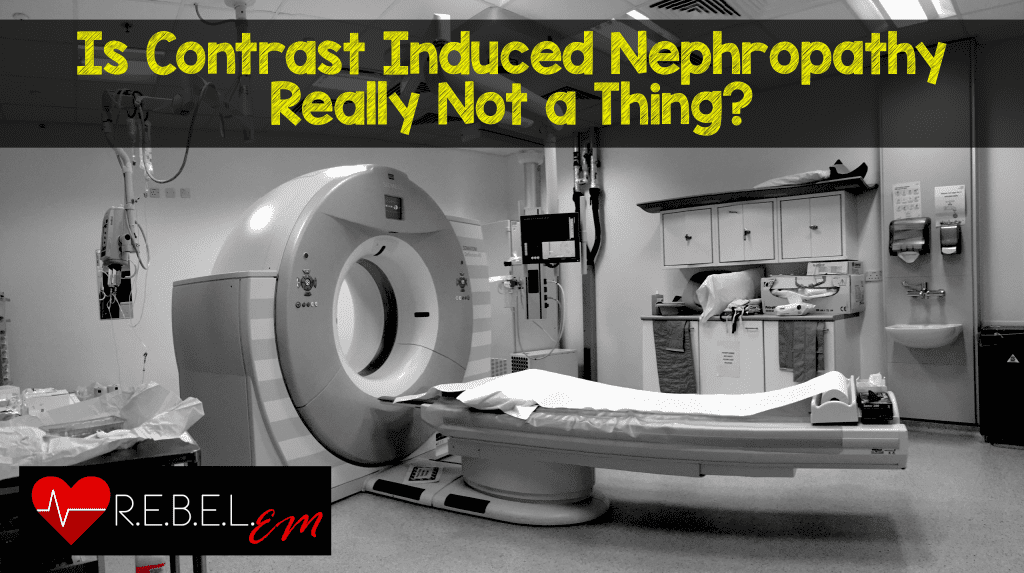 Background: One of the most common imaging modalities used in the emergency department (ED) today is computed tomography (CT) scans using intravenous radiocontrast agents. Use of IV contrast can help increase visualization of pathology as compared to non-contrast CTs. However, many patients do not get IV contrast due to fear of contrast induced nephropathy. Furthermore, waiting for renal function values delays the care of patients and prolongs time spent in the ED with a potential to increase adverse effects on patient centered outcomes due to delays.
Background: One of the most common imaging modalities used in the emergency department (ED) today is computed tomography (CT) scans using intravenous radiocontrast agents. Use of IV contrast can help increase visualization of pathology as compared to non-contrast CTs. However, many patients do not get IV contrast due to fear of contrast induced nephropathy. Furthermore, waiting for renal function values delays the care of patients and prolongs time spent in the ED with a potential to increase adverse effects on patient centered outcomes due to delays.
What They Did:
- Systematic review and meta-analysis of available published literature
- Searched several online databases for relevant articles comparing rates of renal insufficiency, need for renal replacement therapy, or mortality in patients receiving IV contrast vs patients who received no contrast
Outcomes:
Primary Outcome: Development of acute kidney injury
Secondary Outcomes: Need for renal replacement therapy & all cause mortality
Inclusion:
- Noninterventional, adult studies assessing the development of renal insufficiency after contrast-enhanced CT and noncontrast-enhanced CT arms
Exclusion:
- Articles on pediatrics and intra-arterial procedures (including percutaneous coronary angiography)
- Studies on prevention strategies (i.e. N-acetylcysteine, Sodium Bicarbonate drips)
- Case Reports
- Review Articles
- Clinical Guidelines
- Other Meta-Analyses
Results:
- 14,691 articles reviewed
- 28 studies involving 107,335 participants included in final analysis
- 6 studies included only ED patients
- 7 studies assessed ICU patients
- All but one study used low- or iso-osmolar contrast media (contrast media currently in use in most hospitals)
- 82% of studies had patients with CKD
- IV Contrast vs no IV Contrast Enhanced CTs:
- Not Associated with more AKI (Primary Outcome 26 studies): OR 0.94 (95% CI 0.83 – 1.07)
- Not Associated with more Renal Replacement Therapy (13 studies): OR 0.83 (95%CI 0.59 – 1.16)
- Not Associated with Increased Mortality (9 studies): OR 1.0 (95% CI 0.73 – 1.36)
Strengths:
- Followed the Preferred Reporting Items for Systematic Reviews and Meta-Analyses (PRISMA) and the Meta-analysis of Observational Studies in Epidemiology Guidelines (MOOSE)
- Authors hand-searched references of systematic reviews and meta-analyses for additional original articles
- Assessment of the methodologic quality of all included studies using the Tool to Assess Risk of bias cohort Studies (Developed by CLARITY Group at McMaster University)
Limitations:
- All studies reviewed were observational studies, not randomized controlled trials creating a selection bias based on the baseline renal function (i.e. Patients with elevated renal function most likely did not receive IV contrast)
- Most studies reviewed were retrospective in nature
- Moderate heterogeneity amongst included studies evaluating AKI (i.e. type of contrast media used, setting from which CT scan obtained, and differing patient populations – trauma, inpatients, ED, etc…)
- Differing definitions of AKI and timing of renal function measurement amongst studies
- Several studies included the use of nephrotoxic agents, prophylactic medications, and IV hydration prior to CT scans further confounding the results of the studies
Discussion:
- There are no randomized controlled trials addressing this question and, a RCT is unlikely to ever be performed. Observational level data is the highest level of evidence available regarding this issue.
- The majority of studies were ED patients admitted to the hospital or ICU. This creates a selection bias of sicker patients which overestimates the incidence of AKI, need for renal replacement therapy, and mortality when compared to an unselected ED or outpatient population.
Author Conclusion: “We found no significant differences in our principal study outcomes between patients receiving contrast-enhanced CT versus those receiving noncontrast CT. Given similar frequencies of acute kidney injury in patients receiving noncontrast CT, other patient- and illness-level factors, rather than the use of contrast material, likely contribute to the development of acute kidney injury.”
Clinical Take Home Point: While a prospective, multi center RCT would put this question to rest, it’s unlikely to be feasible to perform. Based on the best available evidence, use of IV low- and iso-osmolar contrast media does not appear to be associated with increased risk of AKI, need for renal replacement therapy, or mortality.
References:
- Aycock RD et al. Acute Kidney Injury After Computed Tomography: A Meta-Analysis. Ann. Emerg Med. 2017 [Epub ahead of print]. PMID: 28811122
For More on this Topic Checkout:
- Justin Morgenstern at First10EM: Does Contrast Cause Kidney Injury?: The Evidence
- Anton Helman at EM Cases: Journal Jam 11 – Post Contrast Acute Kidney Injury – PCAKI
Post Peer Reviewed By: Anand Swaminathan (Twitter: @EMSwami)



